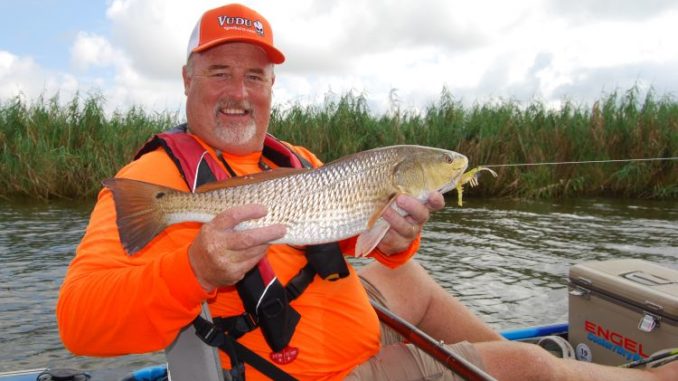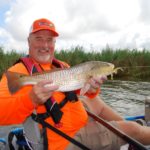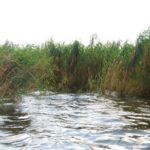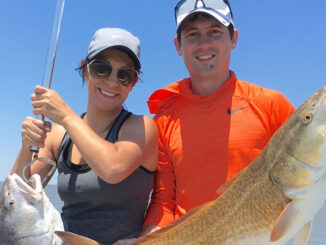
Cast close to roseau canes for quality fish, guide says
Some kayak anglers might be hesitant to toss a popping cork — attached to a twirling 2-foot leader with a Vudu shrimp dangling from the business end — straight at stands of leaning, swaying, hook-grabbing roseau cane, but not Capt. Brian Sherman.
In fact, the closer he gets to the cane — even if that means getting snagged every once in a while — the better he likes it when targeting reds in Yellow Cotton Bay this month.
“You have to be willing to get hung up. You have to,” said Sherman, who owns and operates Kayak Venice. “Some people see the canes as an obstacle, and cast 10 feet short all day long.
“Until you get hung up, you might not catch a fish. The further you get from the canes, there seem to be smaller fish and ladyfish. When you’re tight or up in the little pockets, the bigger fish are hanging there where there’s more cover.”
Sherman said the Mississippi River is beginning a slow fall now and bigger reds are starting to move in, but higher water lately has allowed the fish even more access to get far back into the thick stuff.
“The higher the water, the further back the fish can go. They can swim right through there, with little highways almost like deer runs,” he said. “They’re eating crabs and trapping bait back in the cane.”
Sherman launched his kayak on the side of Tidewater Road right near its intersection with Coast Guard Road in Venice on Monday morning, then into Preston’s Pond followed by a short paddle to the east side of Yellow Cotton Bay.
Vudu shrimp with a chartreuse tail tipped with market bait has been the ticket for redfish in the 18- to 25-inch range lately, he said. Sherman uses Fins Windtamer 40-pound braid along with a 30-pound Seaguar fluorocarbon leader to do battle in the canes.
“If you try fishing with mono line, you’ll break off all day long in there,” he said. “And if you go down to 20-pound fluoro, those canes have all sorts of crustaceans growing on the bottom — it’s like a saw down there working on your line.”
Sherman cruises alongside the cane in his kayak without ever anchoring — deftly pitching his cork into pockets, across points and in spots where he sees water flowing out — constantly covering water.
He even uses the cane as an anchor at times, intentionally guiding his kayak into the thick stuff to position himself for easier casting with the wind or tide.
“I park up on it and use it,” he said. “And if I have a fish on that goes and swims out, I’ll reach back and grab a handful of canes and just hold myself and fight him until he’s tired so he’s not dragging me around out there.”
Sherman only stops to joyfully reel in a redfish, his laughter giving away the fact another red has been hooked — even if he’s obscured deep in the cane.
Manhandling fish away from the cover is a sure way to lose them, he said.
“If you hook one, you have to be patient and willing to let it get wrapped up in the canes. Take your time, and don’t put too much pressure on it so it breaks off. Then go in after it,” he said. “The bigger fish are going to try to run back in the canes, because that’s where they’ve been hiding anyway. They try to run back in there, and trying to horse them out is the worst thing you can do.
“You bust them off, or they wrap around a cane and you cut them off. Let them go and they get themselves hung up, and start thrashing around on the surface, and you don’t put a lot of pressure on them. Tighten your line, work you way back to them and net them and then get everything untangled. Sometimes you’re going to be spitting canes out of your teeth and pulling it out of your nostrils — that’s how it is,” he said with a chuckle. “I’ve had to do it lots of times going in to get peoples’ fish. But it’s effective.”
With a falling river and cooler temps on the way, kayak-fishing should only improve in Yellow Cotton Bay as fall really kicks in — with speckled trout arriving as an added bonus later in the year.
On Monday, when the wind picked up as the morning wore on, Sherman would work an area drifting with the wind, then paddle back into the wind and work the area again if he picked up a few fish.
“The wind is the first thing I look at. Basically, I fish the west side of Yellow Cotton Bay on a west wind and a hard southwest wind,” he said. “I fish the other side in a north or east wind.
“If you find a good spot, make three or four passes through it. It’s almost like drift-fishing a river. I catch a lot of fish moving because I plan my trip so I can cover more area.”




